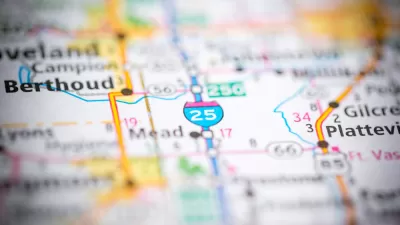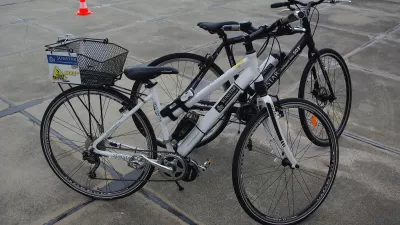A new pilot program in Santa Monica aims to reduce greenhouse gas emissions and provide a testing ground for new technologies.

In an effort to reduce greenhouse gas emissions and air pollution, the city of Santa Monica, in partnership with the Los Angeles Cleantech Incubator (LACI), "have rolled out their one-mile zero-emissions delivery zone," which will "provide priority access to zero-emissions delivery vehicles, including electric vans, e-cargo scooters and remote-controlled small delivery bots, within certain loading zones." Cailin Crowe reports that the city hopes to "alleviate its own last-mile delivery challenges while also supporting its local climate and mobility goals."
With the pandemic accelerating the recent trend toward home delivery of more and more products, the World Economic Forum anticipates 36% more delivery vehicles in cities by 2030. The emissions-free zone "will support the region's work to expedite transportation electrification ahead of the 2028 Olympic and Paralympic Games" and stay on top of the latest green technologies.
"The partners will test a number of innovations within the area, aimed at helping to create local green jobs and improve quality of life, including: electric micromobility solutions, medium and light-duty e-delivery vehicles for goods, and 'first-in-the-nation' commercial medium-duty electric truck-sharing and charging available for small businesses." The city hopes the program will show that "entrenched transportation systems can be changed," said Santa Monica Senior Transportation Planner Kyle Kozar, and create a potential "playbook" for future efforts in emissions-free delivery zones.
FULL STORY: Santa Monica, CA aims to create zero-emissions delivery zone playbook

Maui's Vacation Rental Debate Turns Ugly
Verbal attacks, misinformation campaigns and fistfights plague a high-stakes debate to convert thousands of vacation rentals into long-term housing.

Planetizen Federal Action Tracker
A weekly monitor of how Trump’s orders and actions are impacting planners and planning in America.

In Urban Planning, AI Prompting Could be the New Design Thinking
Creativity has long been key to great urban design. What if we see AI as our new creative partner?

King County Supportive Housing Program Offers Hope for Unhoused Residents
The county is taking a ‘Housing First’ approach that prioritizes getting people into housing, then offering wraparound supportive services.

Researchers Use AI to Get Clearer Picture of US Housing
Analysts are using artificial intelligence to supercharge their research by allowing them to comb through data faster. Though these AI tools can be error prone, they save time and housing researchers are optimistic about the future.

Making Shared Micromobility More Inclusive
Cities and shared mobility system operators can do more to include people with disabilities in planning and operations, per a new report.
Urban Design for Planners 1: Software Tools
This six-course series explores essential urban design concepts using open source software and equips planners with the tools they need to participate fully in the urban design process.
Planning for Universal Design
Learn the tools for implementing Universal Design in planning regulations.
planning NEXT
Appalachian Highlands Housing Partners
Mpact (founded as Rail~Volution)
City of Camden Redevelopment Agency
City of Astoria
City of Portland
City of Laramie





























